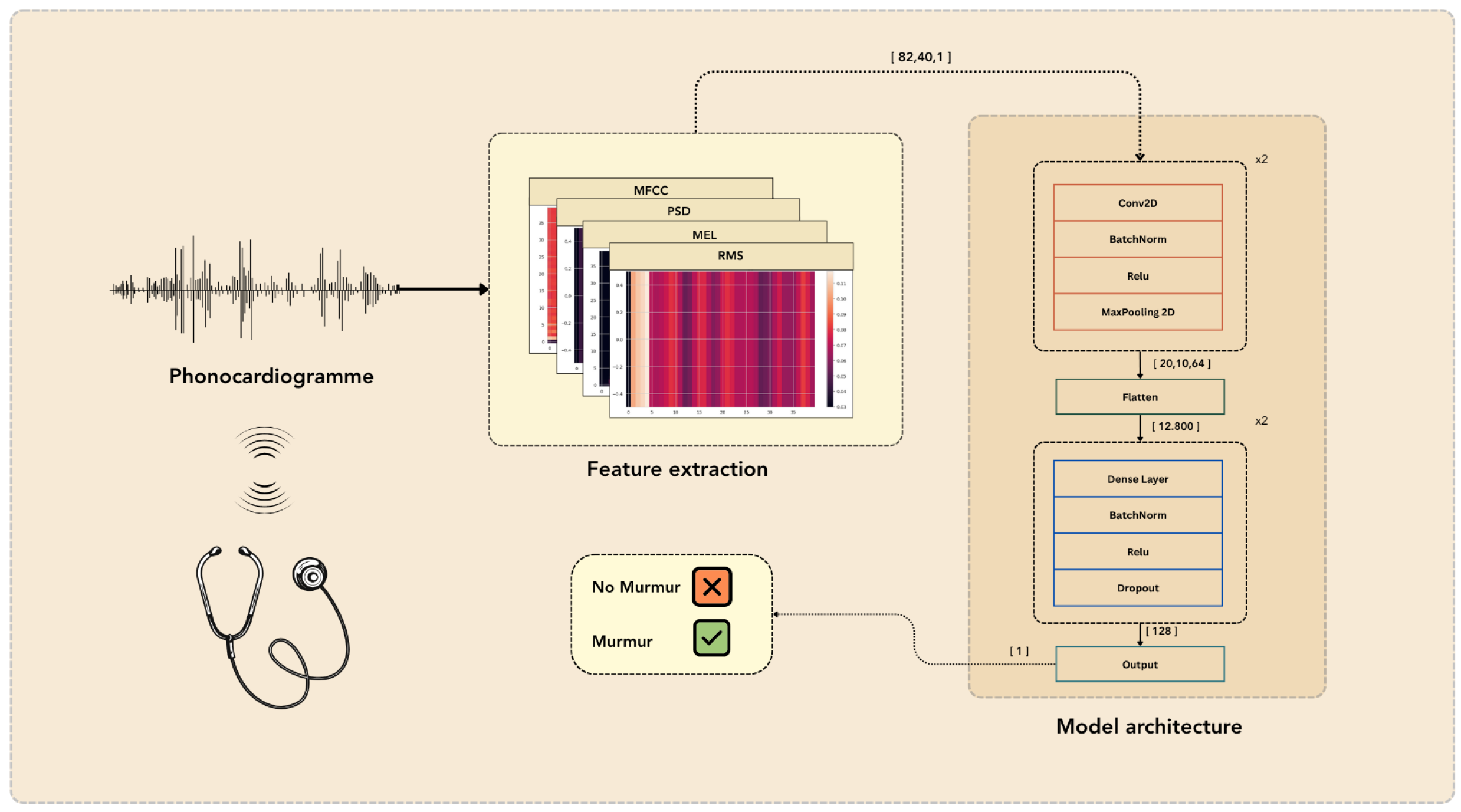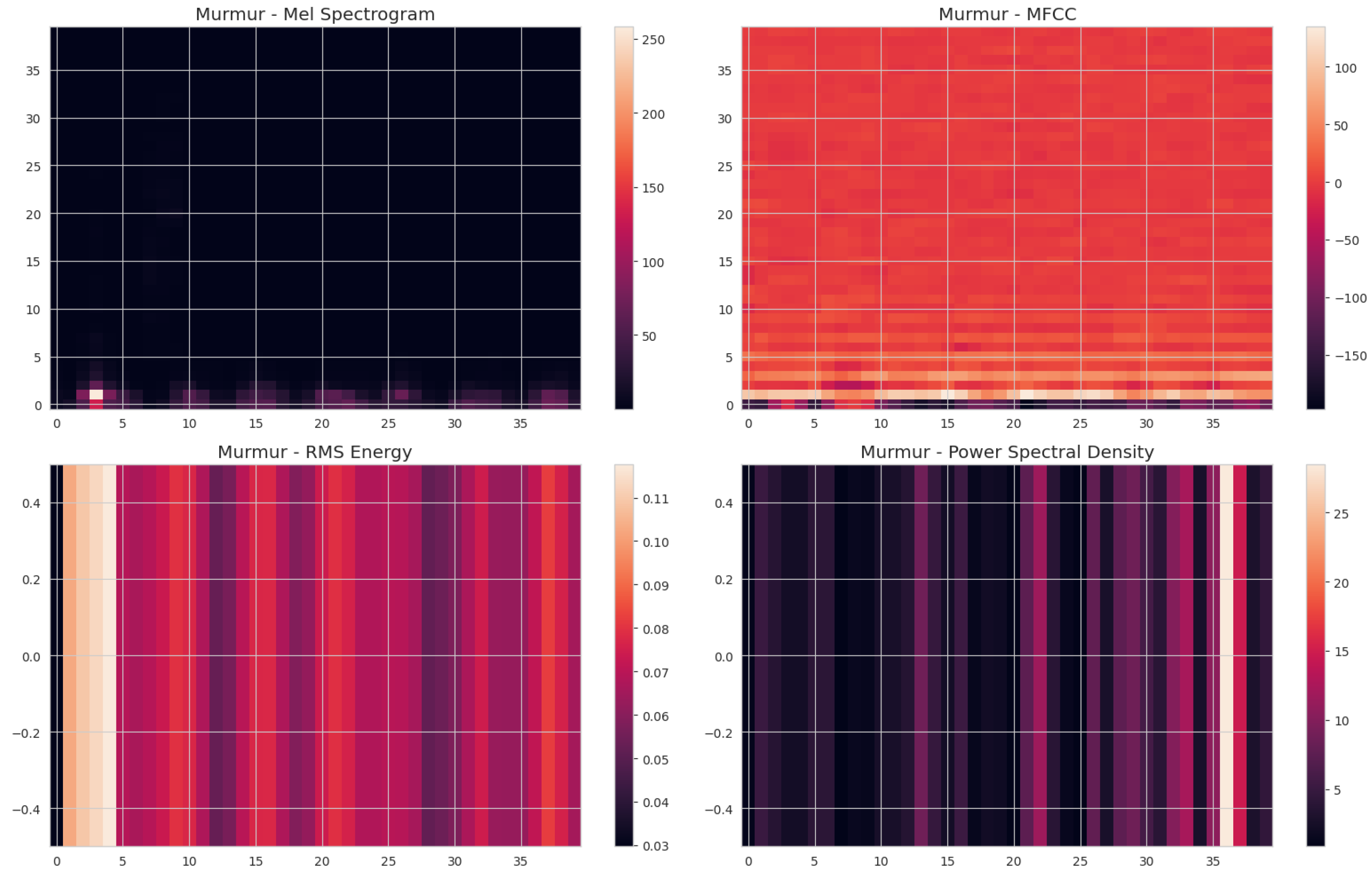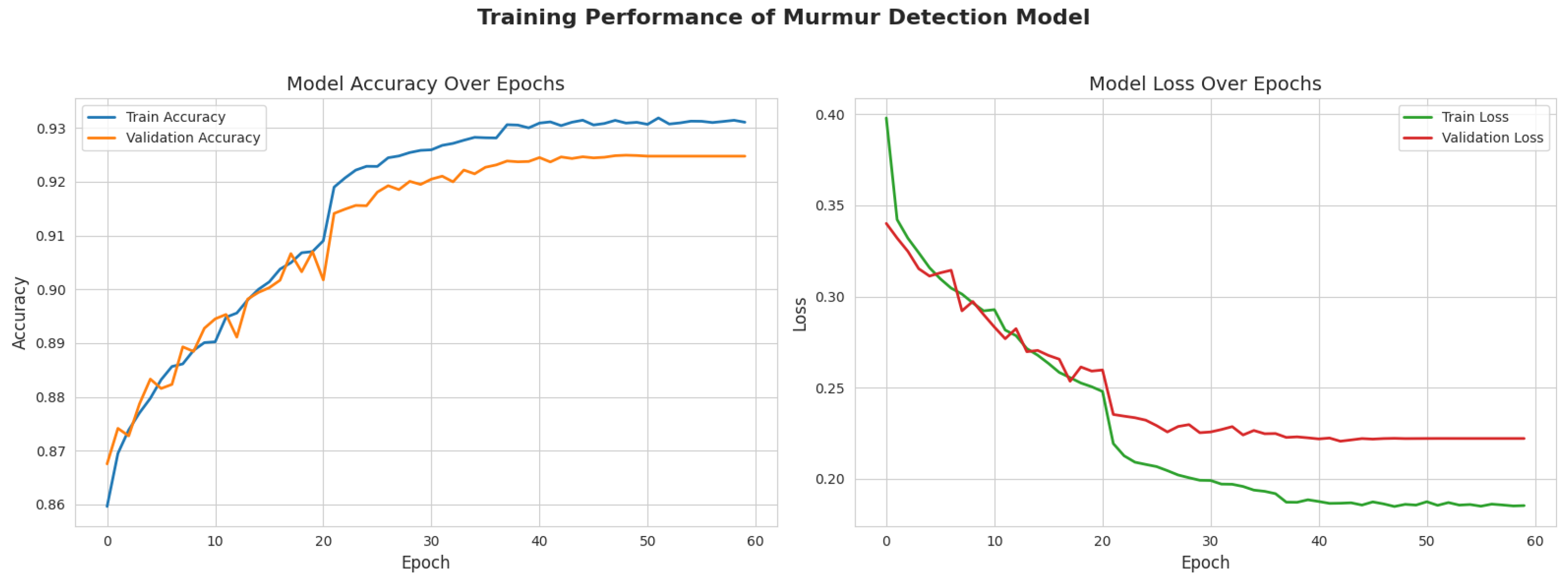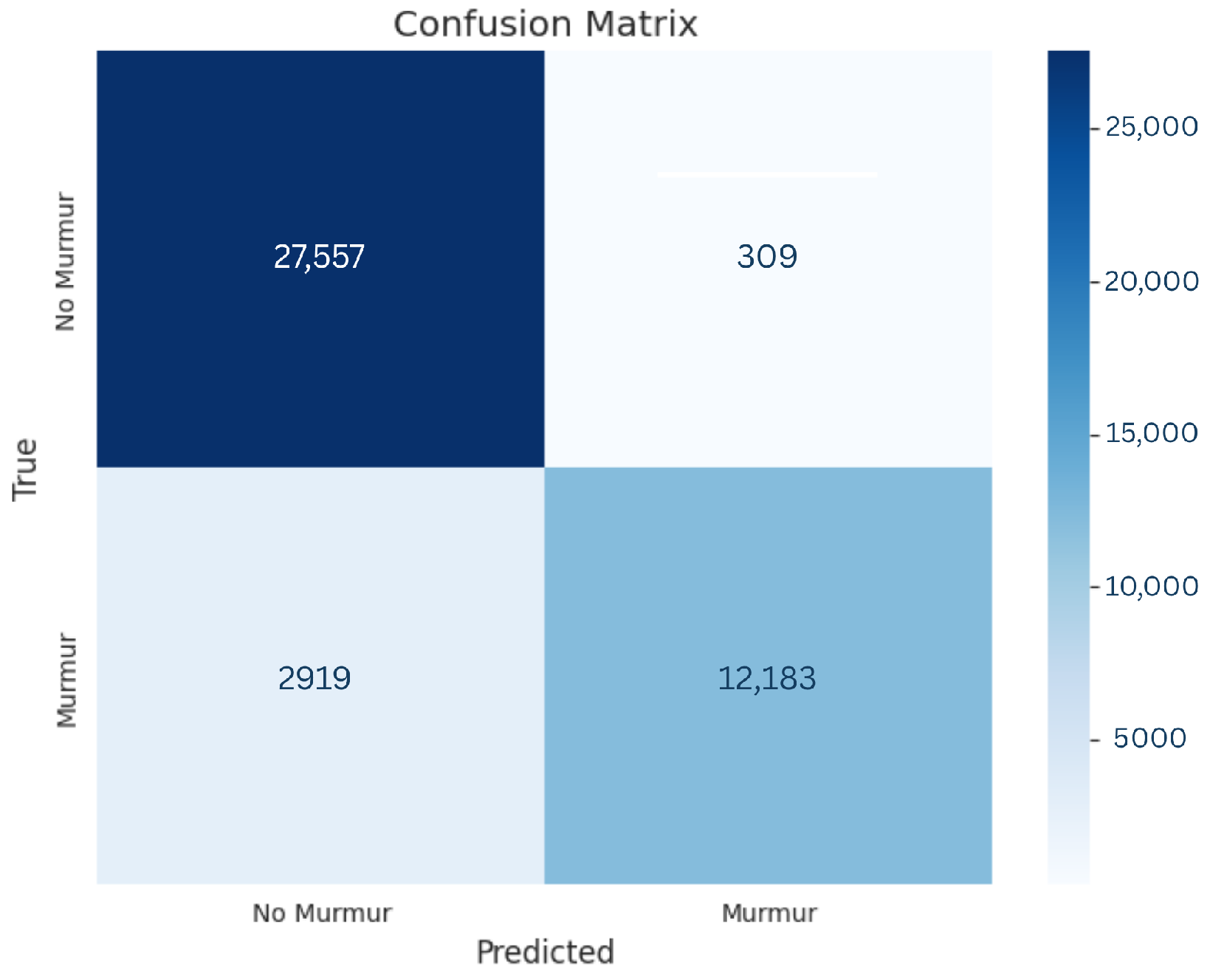A Deep Learning Framework for Early Detection of Potential Cardiac Anomalies via Murmur Pattern Analysis in Phonocardiograms †
Abstract
1. Introduction
- A robust feature engineering approach combining four distinct spectro-temporal representations of PCG signals.
- The application of a 2D-CNN architecture tailored for classifying these fused PCG features for murmur detection.
- An effective data augmentation strategy to enhance model performance and generalization.
- Demonstration of the model’s efficacy on a publicly available dataset, highlighting its potential for clinical applicability as an early indicator for conditions potentially involving arrhythmias.
2. Materials and Methods
2.1. Dataset Description
2.2. Data Preprocessing
- Loading: Audio files in .wav format were loaded using the Librosa library [21], preserving the original sampling rate of 4000 Hz.
- Segmentation: To standardize input size for the CNN, recordings were segmented into 5-second durations. Recordings shorter than 5 s were zero-padded to ensure uniform length.
- Framing for Training Data: In the primary data preparation phase for model training, recordings underwent processing through a sliding window mechanism set at 5 s (win_len = sr * 5), accompanied by a stride of 1 s (stride = sr * 1). This methodology enhances the quantity of samples accessible for training purposes. Each 5 s segment was assigned the murmur label corresponding to the parent recording.
2.3. Feature Extraction
- Mel Spectrogram: The Mel spectrogram was computed by applying a Mel filter bank to the power spectrum of the short-time Fourier transform (STFT) of :where denotes the STFT of the signal and T is the number of time frames (approximately 40 for a 5-s segment).
- Mel Frequency Cepstral Coefficients (MFCCs): The MFCCs were computed by applying a discrete cosine transform (DCT) to the logarithm of the Mel spectrogram:
- Root Mean Square (RMS) Energy: The RMS energy was calculated as:where represents the samples in each analysis frame.
- Power Spectral Density (PSD): A simplified estimate of the power spectral density was obtained using the one-sided magnitude of the Fourier transform:with the resulting array resized to match the temporal resolution T of the other features.
2.4. Model Architecture
2.5. Training and Evaluation
- Data Splitting: The dataset was partitioned into training and testing sets using an 80:20 ratio to ensure proper model evaluation and to avoid data leakage.
- Model Compilation: The CNN model was compiled using the Adam optimizer, with the binary cross-entropy loss function (binary_crossentropy) appropriate for binary classification tasks. Model performance was monitored using the accuracy metric.
- Training Procedure: The training process was conducted over a total of 60 epochs, divided into two phases: an initial training phase of 30 epochs followed by a fine-tuning phase of an additional 30 epochs. A batch size of 32 was used throughout. During fine-tuning, a learning rate scheduler such as ReduceLROnPlateau may have been employed to adaptively reduce the learning rate when the validation performance plateaued, promoting better convergence.
- Evaluation Metrics: The model’s performance was assessed using a comprehensive set of evaluation metrics—accuracy, loss, precision, recall, F1-score, and the confusion matrix—enabling a balanced evaluation of both overall and class-specific performance.
3. Results
3.1. Model Performance
- Test Accuracy: 92.40%
- Test Loss (Binary Cross-Entropy): 0.2242
3.2. Classification Report and Confusion Matrix
4. Discussion
5. Conclusions
Author Contributions
Funding
Institutional Review Board Statement
Informed Consent Statement
Data Availability Statement
Conflicts of Interest
References
- World Health Organization. Cardiovascular Diseases (CVDs). 2021. Available online: https://www.who.int/news-room/fact-sheets/detail/cardiovascular-diseases-(cvds) (accessed on 16 July 2025).
- Kligfield, P.; Gettes, L.S.; Bailey, J.J.; Childers, R.; Deal, B.J.; Hancock, E.W.; van Herpen, G.; Kors, J.A.; Macfarlane, P.; Mirvis, D.M.; et al. Recommendations for the Standardization and Interpretation of the Electrocardiogram: Part I: The Electrocardiogram and Its Technology. Circulation 2007, 115, 1306–1324. [Google Scholar] [CrossRef]
- Rangayyan, R.M.; Lehner, R.J. Phonocardiogram Signal Analysis: A Review. Crit. Rev. Biomed. Eng. 1987, 15, 211–236. [Google Scholar]
- Silverman, M.E.; Wooley, C.F. Samuel A. Levine and the history of grading systolic murmurs. Am. J. Cardiol. 2008, 102, 1107–1110. [Google Scholar] [CrossRef]
- Delling, F.N.; Vasan, R.S. Epidemiology and Pathophysiology of Mitral Valve Prolapse: New Insights into Disease Progression, Genetics, and Molecular Basis. Circulation 2014, 129, 2158–2170. [Google Scholar] [CrossRef]
- Shaver, J.A. Cardiac Auscultation: A Cost-Effective Diagnostic Skill. Curr. Probl. Cardiol. 1995, 20, 441–530. [Google Scholar] [PubMed]
- Arslan, Ö. Automated Detection of Heart Valve Disorders with Time–Frequency and Deep Features on PCG Signals. Biomed. Signal Process. Control 2022, 78, 103929. [Google Scholar] [CrossRef]
- Chen, W.; Sun, Q.; Chen, X.; Xie, G.; Wu, H.; Xu, C. Deep Learning for Heart Sound Classification: A Systematic Review. Entropy 2021, 23, 667. [Google Scholar] [CrossRef]
- Oliveira, J.; Renna, F.; Costa, P.D.; Nogueira, M.; Oliveira, C.; Ferreira, C.; Jorge, A.; Mattos, S.; Hatem, T.; Tavares, T.; et al. The CirCor DigiScope Dataset: From Murmur Detection to Murmur Classification. IEEE J. Biomed. Health Inform. 2022, 26, 2524–2535. [Google Scholar] [CrossRef]
- Durand, L.-G.; Pibarot, P. Digital Signal Processing of the Phonocardiogram: Review of the Most Recent Advancements. Crit. Rev. Biomed. Eng. 1995, 23, 163–219. [Google Scholar] [CrossRef] [PubMed]
- Debbal, S.M.; Bereksi-Reguig, F. Computerized Heart Sounds Analysis. Comput. Biol. Med. 2008, 38, 263–280. [Google Scholar] [CrossRef]
- Choi, S.; Jiang, Z. A Novel Wearable Sensor Device for Continuous Monitoring of Heart Sound. In Proceedings of the 2008 IEEE International Conference on Information and Automation, Pasadena, CA, USA, 19–23 May 2008; pp. 950–954. [Google Scholar]
- Zhou, X.; Guo, X.; Zheng, Y.; Zhao, Y. Detection of Coronary Heart Disease Based on MFCC Characteristics of Heart Sound. Appl. Acoust. 2023, 212, 109583. [Google Scholar] [CrossRef]
- Tavel, M.E. Cardiac Auscultation: A Glorious Past—And It Does Have a Future! Circulation 2006, 113, 1255–1259. [Google Scholar] [CrossRef] [PubMed]
- Varghees, V.N.; Ramachandran, K.I. A Novel Heart Sound Activity Detection Framework for Automated Heart Sound Analysis. Biomed. Signal Process. Control 2014, 13, 174–188. [Google Scholar] [CrossRef]
- Springer, D.B.; Tarassenko, L.; Clifford, G.D. Logistic Regression–HSMM-Based Heart Sound Segmentation. IEEE Trans. Biomed. Eng. 2015, 63, 822–832. [Google Scholar] [CrossRef]
- Chakir, F.; Jilbab, A.; Nacir, C.; Hammouch, A. Phonocardiogram Signals Processing Approach for PASCAL Classifying Heart Sounds Challenge. Signal Image Video Process. 2018, 12, 1149–1155. [Google Scholar] [CrossRef]
- Schölzel, C.; Dominik, A. Can Electrocardiogram Classification Be Applied to Phonocardiogram Data?—An Analysis Using Recurrent Neural Networks. In Proceedings of the 2016 Computing in Cardiology Conference (CinC), Vancouver, BC, Canada, 11–14 September 2016; IEEE: Piscataway, NJ, USA; pp. 581–584. [Google Scholar]
- Latifi, S.A.; Ghassemian, H.; Imani, M. Classification of Heart Sounds Using Multi-Branch Deep Convolutional Network and LSTM-CNN. arXiv 2024, arXiv:2407.10689. Available online: https://arxiv.org/abs/2407.10689 (accessed on 10 March 2025). [CrossRef]
- Chen, T.-E.; Yang, S.-I.; Ho, L.-T.; Tsai, K.-H.; Chen, Y.-H.; Chang, Y.-F.; Lai, Y.-H.; Wang, S.-S.; Tsao, Y.; Wu, C.-C. S1 and S2 Heart Sound Recognition Using Deep Neural Networks. IEEE Trans. Biomed. Eng. 2016, 64, 372–380. [Google Scholar] [CrossRef]
- McFee, B.; Raffel, C.; Liang, D.; Ellis, D.P.W.; McVicar, M.; Battenberg, E.; Nieto, O. librosa: Audio and Music Signal Analysis in Python. In Proceedings of the 14th Python in Science Conference (SciPy 2015), Austin, TX, USA, 6–12 July 2015; pp. 18–24. [Google Scholar]
- Potes, C.; Parvaneh, S.; Rahman, A.; Conroy, B. Ensemble of Feature-Based and Deep Learning-Based Classifiers for Detection of Abnormal Heart Sounds. In Proceedings of the 2016 Computing in Cardiology Conference (CinC), Vancouver, BC, Canada, 11–14 September 2016; pp. 621–624. [Google Scholar]
- Noman, M.F.; Goya, M.S.R.; Islam, M.M. An Efficient Murmur Detection Model Using Integrated RMFB-CNN from PCG Signal. In Proceedings of the 2019 International Conference on Electrical, Computer and Communication Engineering (ECCE), Cox’s Bazar, Bangladesh, 7–9 February 2019; pp. 1–6. [Google Scholar]
- Oh, S.L.; Ng, E.Y.K.; Tan, R.S.; Acharya, U.R. Automated Diagnosis of Arrhythmia Using Combination of CNN and LSTM Techniques with Variable Length Heart Beats. Comput. Biol. Med. 2018, 102, 278–287. [Google Scholar] [CrossRef]
- Shaker, A.M.; Tantawi, M.; Shedeed, H.A.; Tolba, M.F. Generalization of Convolutional Neural Networks for ECG Classification Using Generative Adversarial Networks. IEEE Access 2020, 8, 35592–35605. [Google Scholar] [CrossRef]
- Torres, J.; Oliveira, J.; Gomes, E.F. The Usage of Data Augmentation Strategies on the Detection of Murmur Waves in a PCG Signal. In Proceedings of the 15th International Joint Conference on Biomedical Engineering Systems and Technologies (BIOSTEC 2022), Vienna, Austria, 9–11 February 2022; pp. 128–132. [Google Scholar]
- Leng, S.; Tan, R.S.; Chai, K.T.C.; Wang, C.; Ghista, D.; Zhong, L. The Electronic Stethoscope. Biomed. Eng. Online 2016, 15, 66. [Google Scholar] [CrossRef]
- Simonyan, K.; Zisserman, A. Very Deep Convolutional Networks for Large-Scale Image Recognition. arXiv 2014, arXiv:1409.1556. Available online: https://arxiv.org/abs/1409.1556 (accessed on 10 March 2025).





| Layer Type | Filters/Units | Kernel Size | Activation | Padding | Output Shape (Example) |
|---|---|---|---|---|---|
| Input | – | – | – | – | (None, 82, 40, 1) |
| Conv2D | 32 | (3,3) | ReLU | same | (None, 82, 40, 32) |
| MaxPooling2D | – | (2,2) | – | – | (None, 41, 20, 32) |
| Conv2D | 64 | (3,3) | ReLU | same | (None, 41, 20, 64) |
| MaxPooling2D | – | (2,2) | – | – | (None, 20, 10, 64) |
| Flatten | – | – | – | – | (None, 12,800) |
| Dense | 128 | – | ReLU | – | (None, 128) |
| Dropout | 0.5 (rate) | – | – | – | (None, 128) |
| Dense (Output) | 1 | – | Sigmoid | – | (None, 1) |
| Class | Precision | Recall | F1-Score | Support |
|---|---|---|---|---|
| No Murmur | 0.90 | 0.99 | 0.95 | 27,866 |
| Murmur | 0.98 | 0.81 | 0.88 | 15,102 |
| Accuracy | 0.9240 | 42,968 | ||
| Macro Avg | 0.94 | 0.90 | 0.91 | 42,968 |
| Weighted Avg | 0.93 | 0.92 | 0.92 | 42,968 |
Disclaimer/Publisher’s Note: The statements, opinions and data contained in all publications are solely those of the individual author(s) and contributor(s) and not of MDPI and/or the editor(s). MDPI and/or the editor(s) disclaim responsibility for any injury to people or property resulting from any ideas, methods, instructions or products referred to in the content. |
© 2025 by the authors. Licensee MDPI, Basel, Switzerland. This article is an open access article distributed under the terms and conditions of the Creative Commons Attribution (CC BY) license (https://creativecommons.org/licenses/by/4.0/).
Share and Cite
Edder, A.; Ben-Bouazza, F.-E.; Manchadi, O.; Bigane, Y.A.; Sangare, D.; Jioudi, B. A Deep Learning Framework for Early Detection of Potential Cardiac Anomalies via Murmur Pattern Analysis in Phonocardiograms. Eng. Proc. 2025, 112, 63. https://doi.org/10.3390/engproc2025112063
Edder A, Ben-Bouazza F-E, Manchadi O, Bigane YA, Sangare D, Jioudi B. A Deep Learning Framework for Early Detection of Potential Cardiac Anomalies via Murmur Pattern Analysis in Phonocardiograms. Engineering Proceedings. 2025; 112(1):63. https://doi.org/10.3390/engproc2025112063
Chicago/Turabian StyleEdder, Aymane, Fatima-Ezzahraa Ben-Bouazza, Oumaima Manchadi, Youssef Ait Bigane, Djeneba Sangare, and Bassma Jioudi. 2025. "A Deep Learning Framework for Early Detection of Potential Cardiac Anomalies via Murmur Pattern Analysis in Phonocardiograms" Engineering Proceedings 112, no. 1: 63. https://doi.org/10.3390/engproc2025112063
APA StyleEdder, A., Ben-Bouazza, F.-E., Manchadi, O., Bigane, Y. A., Sangare, D., & Jioudi, B. (2025). A Deep Learning Framework for Early Detection of Potential Cardiac Anomalies via Murmur Pattern Analysis in Phonocardiograms. Engineering Proceedings, 112(1), 63. https://doi.org/10.3390/engproc2025112063






